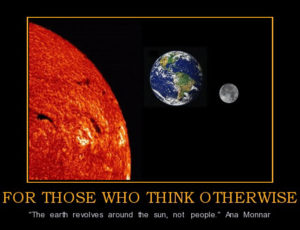If your New Year’s Resolution had anything to do with precision in language, and you have any interest in astronomy, please try to remember the difference between the terms revolution and rotation.
The Earth revolves around the Sun:
It takes a year to do this. In fact, the Copernican Revolution made famous by historian of science Thomas Kuhn, was a well-reasoned and mathematically coherent description of this astronomical fact. The seasons are caused by the 23.5° tilt of its axis. When we’re on one side of our orbit, one hemisphere is tilted closer to the sun; when we’re in the opposite part of the orbit, the other hemisphere faces the sun. The axis is always tilted the same way; it’s just that we’re on different sides of the sun at different times of the year, due to the Earth’s revolution around the Sun.
The Earth rotates on its axis:
It takes a day (and a night) to do this. We rotate from west to east, which makes the sun appear to rise in the east and set in the west. That is, the eastern horizon, where the sun “rises” is the leading edge of our rotation, while the western horizon, where the sun “sets,” is the trailing edge.
Got it?



